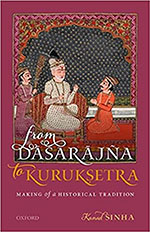A young and yet, already an acclaimed academic, Kanad Sinha has brought out a stunning book entitled From Dasarajna to Kuruksetra. The very utterance on Kurukshetra immediately connects one to the Mahabharata. On the other hand, Dasarajna, literally the battle of ten chiefs who were defeated by another powerful chief, Sudas, on the banks of the river Parushni (modern Ravi) refers to the outstanding political event in the Rigvedic clan society. The book seeks to establish connections between these two battles fought in separate historical epochs. In a significant way, the author delves deep into the social and socio-political processes and journeys between the two unrelated contestations. In this primary premise of Sinha’s scholarly exercise and in the light of his exemplary handling of a vast array of Sanskrit textual sources, the book and its readers may, at first sight, consider that this is a work belonging to the realm of Indology. The subtitle, ‘Making of a Historical Tradition’, on the contrary, is no less crucial than the main title of the book. It immediately alerts the reader that the author is firmly rooted to the methodologies of historical explanations, instead of towing an Indological research agenda. Studies of the Indic pasts have gradually moved away from Indology to the parameters of historical studies, thanks largely to Romila Thapar’s interrogation of historical traditions of remote times. Thapar’s Foreword to this book provides the bedrock to Sinha’s enquiries into historical traditions on the basis of the Vedic corpus, especially the Rigveda, and the Mahabharata.

Culture-specific Ways of Memorizing and Representing the Past
Ranabir Chakravarti
FROM DASARAJNA TO KURUKSETRA: MAKING OF A HISTORICAL TRADITION by Kanad Sinha Oxford University Press, New Delhi, 2021, 548 pp., ₹ 1795.00
March 2023, volume 47, No 3
